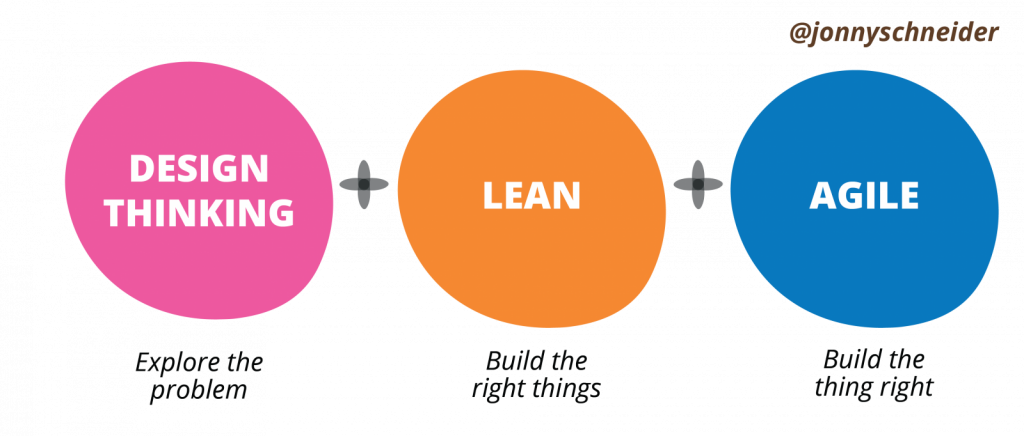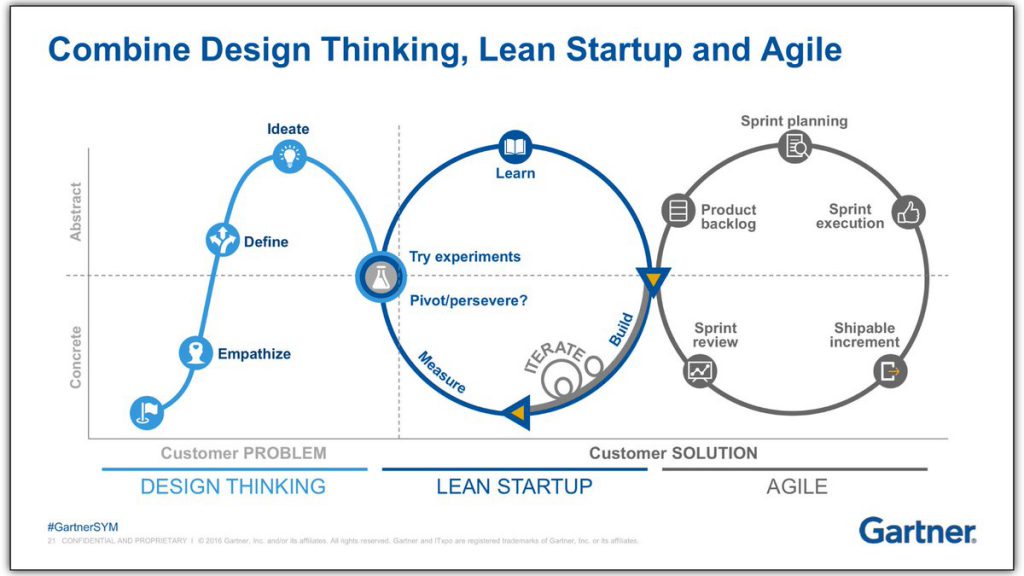THREE STEPS TO SUCCESSFUL INNOVATION
July 10, 2018
We are in the year of “Design Sprints”, and companies are fast adopting the time-boxed approach for business innovation. This new trend is worrisome for several reasons. Before jumping on the bandwagon, companies need to be aware of the risks involved. This blog is my humble attempt to share a detailed account of the pattern I see these days and the pitfalls of the growing trend.
more–>
We as humans are programmed to solve problems, and to achieve that we tend to use every available resource. In 2018, we solve every problem with chatbots, before that, it was blockchain in 2017, bigdata in 2013 and social in 2008. It is a strategic choice to use new and latest technology to improve the current way of working. Implementation of a new technology without taking the right steps is a recipe for project failure.
Since we are in the Startup era, I will not focus on the optimization of What Is, instead we will look at What Can Be i.e. transformation of What Is into something new (innovation).
The process of innovation involves three distinct stages. Identifying these stages will help you avoid project failure by taking the right steps.
Each stage has its own dynamics, goals, and methods. Mixing up these independent stages will inevitably lead to failure.
“Design thinking is how we explore and solve problems; Lean is our framework for testing our beliefs and learning our way to the right outcomes; Agile is how we adapt to changing conditions with software.” – Jonny Schneider
“Three stages of successful business model innovation”

source: https://www.thoughtworks.com/insights/blog/understanding-how-design-thinking-lean-and-agile-work-together
The first stage is Design Thinking, where the new context for innovation is created. It is followed by the Lean (Startup) stage where the idea for the right product is evolved and then Agile is used to keep improving the product in the last stage.
These three stages can be applied to every field and technology, including educational content, consumer products, academic subject fields, etc.
According to Tim Brown, author and CEO of world-renowned design consultancy company, IDEO, “Design thinking is a human-centered approach to innovation that draws from the designer’s toolkit to integrate the needs of people, the possibilities of technology, and the requirements for business success.”
“The lean startup is used to turn these proposed solutions into business models, underpinned by assumptions that are rapidly tested with actual customers to separate truth from fiction, learn and iterate towards product market fit,” said Steve Glaveski, CEO of Collective Campus, an innovation hub, school and consultancy based in Melbourne.
To simplify, Design Thinking helps us come up with better ideas, Lean Startup helps us turn those ideas into business models that work and agile helps us deliver the product to market in a fast, incremental way so that we get ongoing feedback, adapt and deliver precisely what the customer wants.”
Now, let us look at Design Thinking and Lean Startup by breaking them down to their key concepts.

source: https://open-organization.com/en/2016/01/29/three-factors-driving-the-uberization-of-talents/
Content overview of the stages
It is a Herculean task to study every aspect of the three stages in details, so Gartner offers help.

source: “Enterprise Architecture and Technology Innovation Leadership Vision for 2017” -https://www.gartner.com/binaries/content/assets/events/keywords/enterprise-architecture/epaeu17/enterprise_architecture_and__tech-innovation.pdf & https://twitter.com/gartner_sym/status/799174404068560896
Do not skip ahead!
The goal of Design Thinking is that you come up with a new idea (ideate) that is relevant for your context/business. Since there should be no limit while creating something new, the right way to get to this stage is by utilizing proven brainstorming and ideation techniques. This is the very core of innovation. The participants are the ingredients of what is being created at this stage. Thus it is really important to have the “right” people (e.g. subject matter experts) at the table.
When you skip this stage of brainstorming and jump directly to the “how are we going to fix this” stage, you probably miss the root cause of the problem at hand. Jumping straight to Lean Startup or even Agile Production would mean force fitting a technology to a situation. I see this happening around me more often than desired. When I ask a team or client about the “Why” of the innovation, they often have no clear answer. It is my conviction that you should not build something that has no (business) reason to exist.
Having the combination of technology and business issue is not enough to immediately jump to the Agile stage. You should not forget to validate your business issue and match it with the technology and their users.
This approach will also save you a lot of money and stressed employees. If you first set up an Agile team (approx 7 members) and start development, you may notice after a few months that the product/market/people mix is not there.
Lean Startup: Stop thinking, start experiencing and measuring
Eric Ries proposed the Lean Startup methodology in 2008 and published his book Lean Startup in 2011, making a dent in the Startup universe.
Today, the Lean Startup methodology is the standard process to evolve and select available business models. This is a movement against the the earlier method of Strategic Planning and (over) specification. Alex Osterwalder added the famous Business Model Canvas and Value Proposition Canvas to the toolbox.
In the Lean startup phase, you develop ways to validate your assumptions (hypotheses). This includes asking yourself questions like “Do people want this?” and “Do people want to pay for this?”, but most importantly “Does this work?”. Thus your architecture is also part of the Lean Startup stage.
In IT, we learned that focusing on architecture deliverable as a Project Start Architecture provides you with just enough information to kick-start the Agile Production process. It provides guidelines for the development to start getting the Product Backlog ready.
The Lean Startup stage is started with venture capital and the iterations are the guarantee to the investors that the risk level of their long-term investments are reduced. The speed of iteration and learning are the main focus. A major pitfall to look out for at this stage is that the team tends to forget to check if the idea is legal or even(technically) feasible.
Agile Production
Some people say it all started with the (Lean) Toyota Production System, others believe it is the evolution of the Theory of Constraints of Goldratt. We know it is summarized by the Principles defined in the Agile Manifesto. Today, the Agile way is the most used method of producing. In the field of innovation there are many unknowns, therefore it is a must that new functionalities when delivered immediately add business and customer value. The usage of Minimal Viable products or minimum shippable products reduces the operational and financial risks and results in a paced release.
When you start with the Agile way of producing, you need to validate that the steps covered by Design Thinking and Lean Startup are covered. When this is not done and you start producing straight away, it is possible that the effort will be for nothing.
Critical thinking – on the three stages
Before providing some existing framework for each stage, I want to put the focus on the following: Drawing three circles that transform into each other like Gartner did is relatively easy. Suggesting that you should start with brainstorming without boundaries is also easy. Working in sprints is easier said than done. But did you know that it could take up to a year to transform a group of people into a truly empowered, autonomous Agile team?
Design Thinking pitfalls
- Defining a technology in your solution is a big no!
- Not having a mandate from C-Level people is also a big no!
- Not starting with the end-user in mind will result in an inside-out existing process optimization.
- Only using one or two existing brainstorm workshop exercises will not yield the desired result.
It is important to break the construct of the existing reality, and think freely while brainstorming about the possibilities.
All these can be achieved by selecting the right people with the right mindset, mandate and background. What is needed for success in the Lean Startup stage has been summarized really well by Osterwalder.

source: https://twitter.com/strategyzer/status/870622531895644160
These ingredients must be right to get to a successful product with all the context around it.
Lean Startup pitfalls
- When you miss an element of the (Osterwalder) success formula, you will not succeed
- When you fail to validate your product quickly due to the lack of a mandate, right team, or availability of potential clients, the innovation process will fail
Without creating a set of principles on the axis of Business, Information and Technology, you will never know if your product will stand the test of time. The Business Model Canvas provides a great start for the business principles, but one must not forget the other two – axis Information and Technology.
And this might take some time which is not a bad thing. A great way to start prototyping, and evolving the product is by getting your sales funnel up and running and increasing the maturity of your Value Proposition through small iterations. If you do not want to go through this process because you want to build your dream, you might as well skip the whole innovation and just hire a team and become their ruler by dictation.
Many companies skip the ideation and Lean Startup phases and do not prototype their business idea. I think that when you as a company cannot define all the aspects of the Business Model Canvas defined by Osterwalder, you are just kicking the can of your failure down the road. Nothing is worse than not identifying the technology architecture principles correctly at the right time. And investing in it at a later stage does not help.
Stay agile, stay focused, use principles!

 English | EN
English | EN 